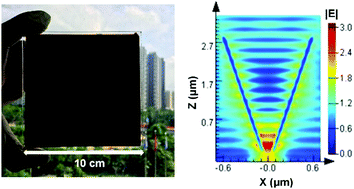Tunable 3D light trapping architectures based on self-assembled SnSe2 nanoplate arrays for ultrasensitive SERS detection†
Abstract
Adopting semiconductor materials with light-trapping architectures as the surface-enhanced Raman spectroscopy (SERS)-active substrates has received increasing attention, in which the multiple reflection and scattering of electromagnetic waves can improve the enhancement factor. However, the fabrication of these semiconductor SERS-active substrates commonly requires complicated processes, and these methods normally result in non-uniform and isolated particles/flakes, which have fundamental difficulties in meeting the practical needs in high performance and reliable SERS substrates. Herein, we demonstrate that SnSe2 nanoplate arrays (NPAs) via self-assembled growth can serve as uniform, highly sensitive and reliable SERS substrates. The cavity formed by the SnSe2 NPAs can trap light efficiently (∼96%) and thus improve the enhancement factor. Benefiting from the synergistic effect of the charge-transfer process and enhanced light trapping, the resulting SERS substrates based on pure SnSe2 NPAs show an ultralow detection limit (1 × 10−12 M), a high enhancement factor (6.33 × 106) and excellent uniformity (relative standard deviations down to 7.7%), demonstrating one of the highest sensitivities amongst the reported semiconductor SERS substrates. Furthermore, the effects of different SnSe2 structural configurations (planar vs. cavity), the height and tilt angle of the SnSe2 NPAs on the performance of SERS detection are systematically investigated. It is discovered that the SERS performance is strongly dependent on both the light-trapping ability and the absorption loss. We believe that our results not only provide an effective strategy to obtain tunable, uniform and high performance SERS substrates, but also lead to further understanding of designing 3D light trapping architectures.



 Please wait while we load your content...
Please wait while we load your content...